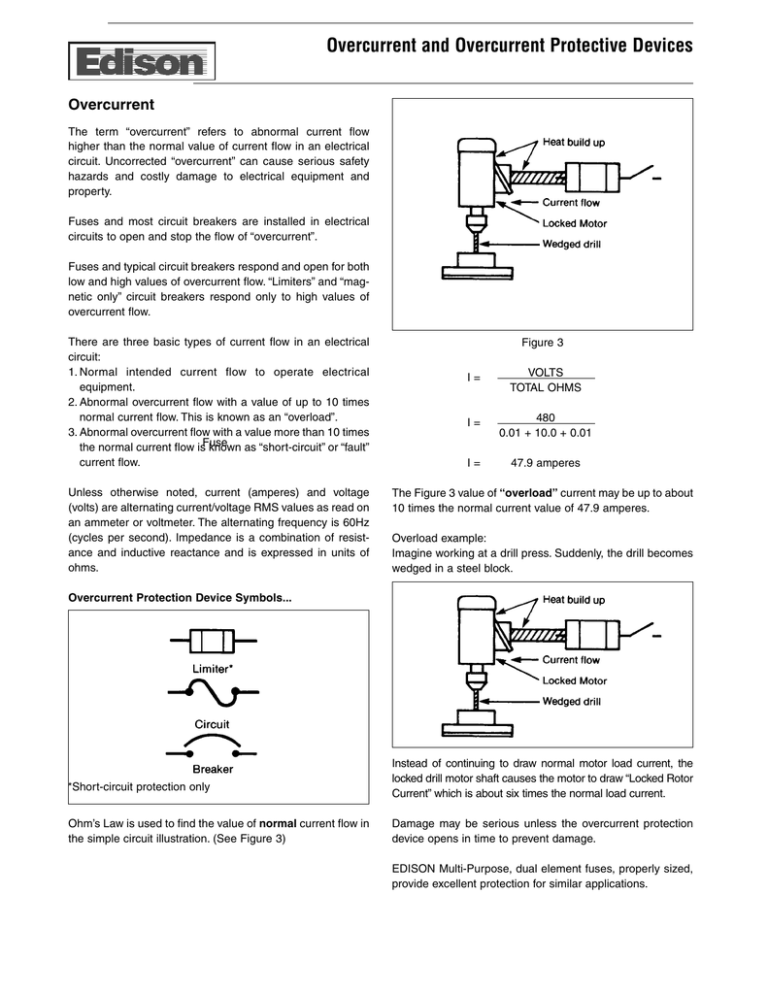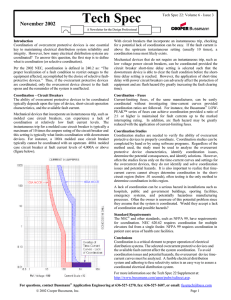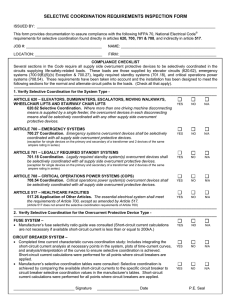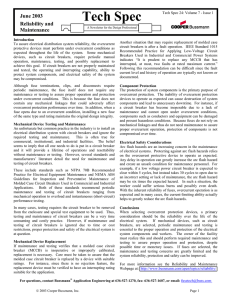Overcurrent and Overcurrent Protective Devices Overcurrent
advertisement

Overcurrent and Overcurrent Protective Devices Overcurrent The term “overcurrent” refers to abnormal current flow higher than the normal value of current flow in an electrical circuit. Uncorrected “overcurrent” can cause serious safety hazards and costly damage to electrical equipment and property. Fuses and most circuit breakers are installed in electrical circuits to open and stop the flow of “overcurrent”. Fuses and typical circuit breakers respond and open for both low and high values of overcurrent flow. “Limiters” and “magnetic only” circuit breakers respond only to high values of overcurrent flow. There are three basic types of current flow in an electrical circuit: 1. Normal intended current flow to operate electrical equipment. 2. Abnormal overcurrent flow with a value of up to 10 times normal current flow. This is known as an “overload”. 3. Abnormal overcurrent flow with a value more than 10 times the normal current flow isFuse known as “short-circuit” or “fault” current flow. Unless otherwise noted, current (amperes) and voltage (volts) are alternating current/voltage RMS values as read on an ammeter or voltmeter. The alternating frequency is 60Hz (cycles per second). Impedance is a combination of resistance and inductive reactance and is expressed in units of ohms. Figure 3 I= VOLTS TOTAL OHMS I= 480 0.01 + 10.0 + 0.01 I= 47.9 amperes The Figure 3 value of “overload” current may be up to about 10 times the normal current value of 47.9 amperes. Overload example: Imagine working at a drill press. Suddenly, the drill becomes wedged in a steel block. Overcurrent Protection Device Symbols... *Short-circuit protection only Ohm’s Law is used to find the value of normal current flow in the simple circuit illustration. (See Figure 3) Instead of continuing to draw normal motor load current, the locked drill motor shaft causes the motor to draw “Locked Rotor Current” which is about six times the normal load current. Damage may be serious unless the overcurrent protection device opens in time to prevent damage. EDISON Multi-Purpose, dual element fuses, properly sized, provide excellent protection for similar applications. Overcurrent and Overcurrent Protective Devices Overcurrent Protection Devices...fuses and circuit breakers Fuses contain an element that acts like a conductor for the normal current flow. The element’s ability to sense abnormal current is the basis for the amp rating of the fuse. When an overcurrent develops that exceeds the fuse rating, heat builds up inside the fuse and melts or “opens” the element. Once the element is melted and the arc extinguished, current flow stops. When the overload or fault condition that caused the fuse to open is corrected, a proper replacement fuse restores the original dependable protection. Figure 4 Figure 4 is identical to Figure 3 except a short-circuit fault has been shown that by-passes the impedance of the load of 10 ohms. The only impedance remaining to oppose the flow of current is 0.02 ohms which is the total impedance of the conductors. Short-circuit current now flows around the load as shown by the arrow in the heavy line. The value of short-circuit current flow for this simple illustration is determined by using Ohm’s Law: VOLTS ISC = TOTAL OHMS ISC = 480 = 24,000 amperes 0.02 There are many specific ways that short-circuits (faults) may occur. Some of the more common are accidents, carelessness in the misuse of “fish tape”, tools, etc., crossed phases, contamination, rodents, damaged insulation and unfused small conductors. Fuse showing element during normal operation Element intact Fuse showing element melted by an overcurrent Element melted Circuit Breakers contain a resettable latch which acts like an “ON-OFF” switch for the normal current flow. When abnormal current flows through the circuit breaker, the latch trips, and the indicator on the outside of the circuit breaker moves into the “OFF” position. Once the overcurrent problem has been corrected, the indicator lever can be reset into the “ON” position, which simultaneously resets the latch inside the circuit breaker. Breaker "ON" Overcurrent and Overcurrent Protective Devices When fuses and circuit breakers are properly applied within their interrupting rating, as required by N.E.C. 110.9, device opening during short-circuit current flow generates high levels of energy inside the devices. EDISON current limiting fuses are designed to retain their high interrupting rating in normal use until caused to open and are then replaced with a new fuse. Breaker "OFF" Summary It is obviously necessary to rate fuses and circuit breakers according to their ability to safely interrupt a given MAXlMUM value of short-circuit current flow. Standard UL Fuse Interrupting Ratings* Class H 10,000 Class K 50,000, 100,000 or 200,000 Classes J, L, R, T, and CC 200,000 Class G 100,000 Standard UL Circuit Breaker Interrupting Ratings* 5,000 7,500 10,000 14,000 18,000 22,000 25,000 30,000 35,000 *Contact manufacturer for availability of ratings. 42,000 50,000 65,000 85,000 100,000 125,000 150,000 200,000 Figure 5 A specific fuse or breaker may be submitted for testing at one of the standard levels shown in Figure 5. The successful product testing results in “listing” of the product as having an “interrupting rating” (I.R.) at the level of test current. In other words, when a fuse or circuit breaker will safely interrupt developed energy at a specific value of short-circuit current, say 200,000 Irms, the product manufacturer may place a UL logo and words similar to “Interrupting Rating 200,000 Amps A-C” on the product label. The product will interrupt any value of fault current up to 200,000 Irms MAXIMUM.




